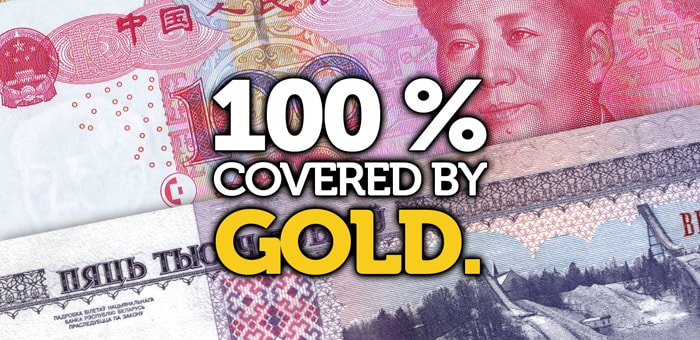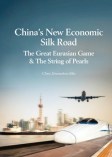China and Russia’s Strategy to End US Dollar Trade Dominance


Both China and Russia have been developing, apparently in tandem, strategic plans to unseat the US dollar as the globally dominant currency. The thinking behind this dates back to March 2009, when China and Russia called for a new global currency. They want the world to create a reserve currency “that is disconnected from individual nations and is able to remain stable in the long run, thus removing the inherent deficiencies caused by using credit-based national currencies.” Both countries are concerned that the trillions they both hold in dollars would be worth less should dollar inflation sets in.
This could happen as a result of increased American deficit spending and printing of the dollar by the U.S. Treasury to support U.S. debt. China called for the International Monetary Fund to develop a currency to replace the dollar. Nothing has happened on that front (The IMF is largely American controlled) and therefore the Chinese, in conjunction with Russia, have stepped up their desire to initiate change. This has further developed due to a realization that in terms of financial transfers, the U.S has the capability to, and does track, every financial transaction going through US banks and using dollars. Of especial interest are all transactions of US$10,000 or more. If our readers have ever transferred more than this amount, regardless of where the transaction took place, the U.S. authorities know about it.
But providing an alternative to U.S control and monitoring of the global banking and financial markets is not going to be easy. The following statistics illustrate just how powerful the US hold is on global financial markets:
| The US Dollar In Numbers | |
|---|---|
| Value of US$ Held Outside The US? | 580 Billion |
| Amount Of Global GDP Coming From Countries With Dollar Pegs? | 30% |
| Amount of Global Forex Trading Using US$? | 85% |
| Percentage Of World Debt Issued In US$? | 39% |
| Non-US Global Foreign Reserves In US$ Held By Banks? | 18 Trillion |
However, China and Russia can provide significant clout of their own. Russia, when measured according to criteria laid down in the classic book “The Wealth of Nations” would by far and away be the wealthiest country in the world, with some distance between it and the United States, which would not feature in the top three (Canada and Australia would). This is because a set of demographics as illustrated in Smith’s book come into play which are essentially based on available resources: Precious metals and similar products, human capital (in the right quantity and education), infrastructure, and free trade.
Russia is a major supplier of oil and gas, and has significant reserves in the ground. It is also the worlds largest producer of diamonds, and along with China has significant reserves of rare earths and other valuable, in demand commodities (as does Mongolia, which lies in between). China is both the worlds largest producer, and consumer of gold. Russia is also a major producer of gold, while both countries are keen to combine their reserves, expand production of gold, and other precious metals, and buy up gold reserves to provide one element to challenge US currency dominance. The United States also has significant gold reserves, although how much is actually held by the Americans is increasingly being questioned. Some countries, such as Germany, have demanded their gold reserves be returned to them ironically because it is felt that an invasion by Russia, or as was, the Soviet Union, is no longer likely.
| Top Ten Gold Reserves Held, By Country | |
|---|---|
| Nation | Amount (Tonnes) |
| United States | 8,133 |
| Germany | 3,381 |
| Italy | 2,453 |
| France | 2,435 |
| China | 1,797 |
| Russia | 1,460 |
| Switzerland | 1,040 |
| Japan | 765 |
| Holland | 612 |
| India (source: US Funds) |
558 |
Currently, the Chinese and Russian reserves combined would place them with the second largest reserves. However, both are actively seeking to close the gap with the United States. Should they achieve that aim, which may be a decade or so off, then the emotional impact upon the global financial markets could be significant, as can be seen in our lead image above. China also controls the Shanghai based Silk Road Gold Fund, which is actively involved in providing equipment and infrastructure to the more remote, and poorer areas of the Belt and Road countries, principally in Central Asia. This fund finances the extraction of known gold reserves and splits the value with the nation concerned, this helping the local government obtain more financial security, and adding to China’s own gold reserves. Russia is a major investor in this fund.
China and Russia openly list their gold as a strategic monetary asset, while the United States has continually sought to underestimate the strategic value of the precious metal because, at present, it remains the biggest single danger to the hegemony of the dollar.
But it is not only gold that is determining how the battle against US dollar dominance is shaping up.
In terms of oil, the United States is not in the top ten of global producers, and has instead been reliant on political and dubious regional involvement to secure and influence supplies and control of known global reserves. The world’s top ten proven oil reserves are held by the following countries:
| Nation | Reserves (billions of barrels) |
|---|---|
| Venezuela | 298 |
| Saudi Arabia | 268 |
| Canada | 173 |
| Iran | 156 |
| Iraq | 141 |
| Kuwait | 104 |
| United Arab Emirates | 98 |
| Russia | 80 |
| Libya | 48 |
| Nigeria (Source: Global Europe Anticipation Bureau) |
37 |
Concerning proven natural gas reserves, these are the top ten:
| Nation | Reserves (trillion cubic feet) |
|---|---|
| Russia | 1,688* |
| Iran | 1,187 |
| Qatar | 885 |
| Turkmenistan | 353 |
| United States | 334 |
| Saudi Arabia | 290 |
| United Arab Emirates | 215 |
| Venezuela | 195 |
| Nigeria | 182 |
| Algeria (Source: Hydrocarbons Technology) |
159 |
| *Russia’s share equates to 25% of the total global reserves | |
Although China isn’t a significant producer of oil or gas (one reason it does not feature prominently in the Wealth of Nations), it is a major buyer, and is well known to have the world’s largest foreign financial reserve, which at US$3.52 trillion is three times more than the next largest (Japan).
| Largest Foreign Currency Reserves By Nation | |
|---|---|
| Country | Amount (Billions, US$) |
| China | 3,520 |
| Japan | 1,321 |
| European Union | 819 |
| Switzerland | 661 |
| Saudi Arabia | 581 |
| Russia | 407 |
| Hong Kong | 380 |
| South Korea | 372 |
| India | 366 |
| Brazil (Source: Investopedia) |
362 |
That financial clout has lead to the RMB being dubbed as a Petro currency, “The Petroyuan”, although much of that is spent in Russia, Saudi Arabia, and Iran. Nonetheless, China and Russia’s use of yuan-denominated crude oil futures will help promote the ascendancy of the renminbi. And although China’s weight in the crude oil market is not by itself sufficient to shake the global dominance of the petrodollar, its status as the world’s largest crude oil importer will certainly help solidify the petroyuan’s positions, with even US energy companies showing interest in exporting shale oil to the Asian economic powerhouse.
There are significant arguments to also support the thesis that much of the American-led drive to initiate and bring the EU in to support sanctions against Russia as a punishment for the situation concerning the Ukraine and Crimea, the underlying reason, which is apparently supported by the nature of the most recent layer of Russian sanctions, is that the United States wishes to stop Russia exporting gas to the EU, and sell it US produced gas instead.
Looking forward, the economic return to a financial system based on real value, as opposed to credit, is a cornerstone view both of “The Wealth of Nations”, and one held by China and Russia. It is one reason why Russian Venture Capitalist Alexander Boroditch recently suggested backing cryptocurrency technologies with natural resources.
There are also significant moves by China and Russia and to some extent India, to challenge global financing. The three countries are the three largest shareholders in the Asian Infrastructure Investment Bank, which while not an immediate game-changer, will divert internationally available funds to infrastructure developments that will more suit their political and development aims as opposed to those of the United States. They are all of course members of the BRICS group of nations as well as the regionally powerful Shanghai Co-Operation Organisation. Should China and India sign Free Trade Agreements with the Moscow supported Eurasian Economic Union, as seems likely, this supports another of the arguments contained within “The Wealth of Nations” – that of free trade. This is occurring just at a time when the United States seems to be disengaging from the concept.
Both China and Russia are to some extent bypassing the US dollar today. Russia has started to raise money from Asian investors by issuing bonds in RMB while the Yuan is also now traded in Moscow. It is becoming more common to see China’s Union Pay acceptance credit cards rather than Visa as the joint-clearing service is rolled out across Russia.
In terms of infrastructure, both China and Russia are moving ahead of the United States, and to some extent the EU, with their planned adoption of the new 5G generation and advances being made to support trade via blockchain technologies. Again, the development of free trade through ease of transactions, and embracing new technologies, are part of the “Wealth of Nations” thesis.
At present, it will take some time for China and Russia to shake off American dollar dominance. However, it is worth keeping an eye on the gold reserve holdings being developed by both countries, and of other significant wealth being created. Russia is also for example, the world’s largest producer of diamonds, although this impacts largely upon the gem business and has little intrinsic value to an economy. But oil and gas do, and China’s purchasing might, coupled with Russia’s supply dominance, shape up to provide an entertaining, and potentially deadly battle with the United States over the protection of the dollar’s hegemony. As Alexander Boroditch suggested, should more support be given to credit-adverse financiers who wish to see real assets lined up behind their investments, then moves to change the global reliance of credit might start to gather steam, and especially in another financial crisis along the lines of the US-instigated sub-prime disaster arrive. That event put the United States on notice that its credit based system and US dollar dominance is not infallible, and may not even be advisable in a global economy.
Meanwhile, the attempts by China and Russia to affect how the global supply chain is financed and in what form, is an issue that is already being played out along the One Belt, One Road routes and one that will ultimately, affect us all.
About Us
Chris Devonshire-Ellis is the Founding Partner and Chairman of Dezan Shira & Associates, as well as a Visiting Lecturer at the Russian Higher School of Economics, where he teaches on International Trade In Asia. He may be contacted via silkroad@dezshira.com.
 Related Reading:
Related Reading:
![]() Trump Out, Xi and Putin In – China, Russia Want Asia-Pacific Free Trade Deal
Trump Out, Xi and Putin In – China, Russia Want Asia-Pacific Free Trade Deal
The Wealth of Nations
The Wealth of Nations was published 9 March 1776, during the Scottish Enlightenment and the Scottish Agricultural Revolution. It influenced a number of authors and economists, as well as governments and organizations. For example, Alexander Hamilton was influenced in part by The Wealth of Nations to write his Report on Manufactures, in which he argued against many of Smith’s policies. Interestingly, Hamilton based much of this report on the ideas of Jean-Baptiste Colbert, and it was, in part, Colbert’s ideas that Smith responded to with The Wealth of Nations. Many other authors were influenced by the book and used it as a starting point in their own work, including Jean-Baptiste Say, David Ricardo, Thomas Malthus and, later, Ludwig von Mises. The Russian national poet Aleksandr Pushkin refers to The Wealth of Nations in his 1833 verse-novel Eugene Onegin.
Silk Road and OBOR Business Intelligence
Dezan Shira & Associates´ Silk Road and OBOR investment expertise provides an introduction to the Belt & Road countries and an overview of the services provided by the firm. Dezan Shira has considerable regional experience throughout Asia, including the Eurasian routes involving China and Russia as well as the Maritime routes throughout South-East Asia. We can assist with Belt & Road analysis and investment intelligence in this complex yet exciting region and possess multiple offices across the Silk Road routes.
Dezan Shira & Associates’ Service Brochure
Dezan Shira & Associates´ brochure offers a comprehensive overview of the services provided by the firm. With its team of lawyers, tax experts, auditors and consultants, it is Dezan Shira´s mission to guide investors through Asia´s complex regulatory environment and assist with all aspects of establishing, maintaining and growing business operations in the region.
China’s New Economic Silk Road
This unique and currently only available study into the proposed Silk Road Economic Belt examines the institutional, financial and infrastructure projects that are currently underway and in the planning stage across the entire region. Covering over 60 countries, this book explores the regional reforms, potential problems, opportunities and longer term impact that the Silk Road will have upon Asia, Africa, the Middle East, Europe and the United States.









